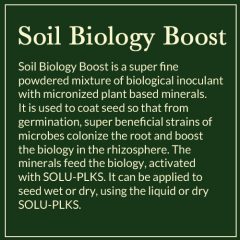PLEASE NOTE: We are not currently selling products but you can contact the suppliers listed on the Soil & Plant Products page from whom you can order.
These sea based minerals were developed by Jerry Brunetti, DVM to heal animals (called DynaMin). When micronized into small particles, they also feed microbes and assist their growth.
Specifically, we use this mineral blend to feed the beneficial anaerobic and facultative anaerobic lactobacilli in the Beneficial Anaerobic Fermentation & Probiotic Culture (BAF&P).
Together, these products make a great treatment for curing hay and silage in a way that eliminates spoilage and improves nutrition dramatically of the forage and the animal performance of those eating it.
Ultrafine powder – micronized trace minerals
1/2 oz per dry matter ton forage
For use with BAF&P to ferment forages & hays
- About
- Benefits (when used with BAF&P)
- Application Recommendations
- Field Notes from Our Research
- Product Info Sheet
- Label
- Material Safety Data Sheet
These sea based minerals were developed by Jerry Brunetti, DVM to heal animals (called DynaMin). When micronized into small particles, they also feed microbes and assist their growth. Specifically, we use this mineral blend to feed the beneficial anaerobic and facultative anaerobic lactobacilli in the Beneficial Anaerobic Fermentation & Probiotic Culture (BAF&P). Together, these products make a great treatment for curing hay and silage in a way that eliminates spoilage and improves nutrition dramatically of the forage and the animal performance of those eating it.
Share On
- Create Nutrient Dense Hay - increases vitamins, minerals and energy. The beneficial fermentation microbes produce a lot of substances beneficial to gut health. Improves nutritive feed value and medicinal properties.
- Reduce the need to avoid rain when baling hay – hay can be cut at the proper time as opposed to waiting too long to cut due to rainy forecasts (higher nutrients as forages lose roughly one percent protein each day after boot stage as they get overmature and turn to lignin. Hay can be rained on and still come out superior in forage quality and animal performance to normally cured hay
- Reduce equipment; no need to tedder the hay – reduces fuel cost, wear cost, operator cost, total time and energy invested in the hay, as well as reducing compaction on the land.
- Do not need plastic or special equipment to bale – if your baler or equipment can not handle the weight of forages fermented in plastic, hay can be dried down to 20% moisture and the animals can still tell the difference
- Turn lower quality “waste” into high quality & energy feed* – you can use the Beneficial Anaerobic Fermentation & Probiotic Culture (BAF&P) and CITM on wheat, corn, and rye straw/stalks to turn low cost feed into higher value feed.
- Virtually no mold or spoilage when done right - less loss!
Share On
Spray hay with BAFP & CITM mixture when first cut, OR when moist/wet (if rained on). The microbes need moisture to ferment.
- Always use with BAFP
- Mix just before spraying.
- 1/2 oz of CITM per dry matter (DM) ton of forage with appropriate BAFP amount (1/2-1 gal per DM ton) to provide mineral energy for the biology.
- CITM dissolves easily but do a test before adding the sprayer to avoiding clogging.
- Sometimes we use a little warm water to first dissolve the CITM, or mix BAFP and CITM in a separate container first.
You can put up forages from 15-75% moisture using these microbes; in bales, bags, pits etc. You do not have to use plastic.
Share On
If baled at higher moistures, and when there is a higher legume content in the hay, fermentation will take longer (depending on forage type). The length of the process will vary depending on forage type, moisture when baled, native species in the field where cutting, humidity, altitude, barometric pressure, and oxygen availability. It is generally ready once the temps come down to below 90 degrees F.
The animals will tell when it is ready, or you can use it when the pH drops to around 4.5.
Sometimes native fungal species will look and smell like they are taking over during the initial fermentation. We even had mushrooms growing out of our high moisture hay bales, and I thought it was ruined the first time I tried it. Have faith as the beneficials will win if the product was applied correctly 🙂
Hay will heat but can be stacked in barns - monitor temps. Our high moisture bales got to 160+ but then came down. The drier cured hay only heated to 140. We were worried about fires when we first started using this product, but are starting to understand that if the beneficials are in there, the heating curve does not go exponentially volatile like when hay is molding and spoiling with pathogens.
If you do not use plastic, the outside of the bales can get a chalky, powdery white substance that looks like mold, but when tested it is actually a beneficial yeast.
Share On




